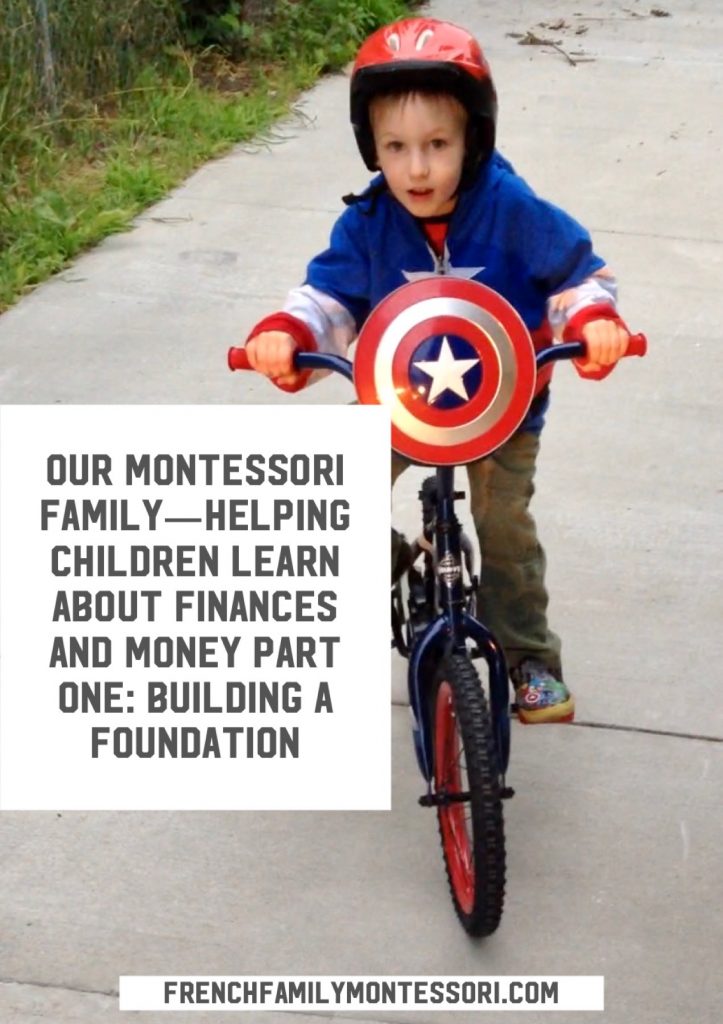
Being a financial coach, I’ve been asked how to teach children to handle money. As a Montessori parent, I’ve been asked how to introduce money and ways of handling it to children. While I often give basic advice as a financial coach, below, while similar, is more of a step-by-step, as a Montessori parent.
I’ve heard some say that children shouldn’t be exposed to finances and money, as it’s an “adult” topic and they shouldn’t be burdened. The reality is that we need to prepare our children to handle their own finances, appropriately and over time.
It starts with children hearing us talk about money. Saying things like, “It’s not in the budget,” “Ooo, I’ll need to save up for that,” “Yes, we have the money for that,” are things that children should be exposed to early on. The girls don’t know what money is, but they hear us talk about it and the budget regularly. I tell them when I’m going to balance the accounts and we talk about investments around them.
This is part of: Talking about money, appropriately. Children don’t need to know about financial struggles. Never place financial burden on your children’s shoulders. They need to feel safe and secure, not worried about food and a shelter over their head. It’s ok to say, “That’s not in the budget” or “We have our money set aside for something else right now.” However, I highly recommend avoiding the phrase, “We’re poor,” even jokingly. (Being broke is a temporary situation. Being poor is a state of mind.-Mike Todd)
Your child also doesn’t need to be privy to how much the household income is. (You may decide to share this information when they hit a certain level of maturity or age.) They can, however, be part of budgeting. That conversation can look like this: “We have $300 after bills and necessities. We were thinking $200 for savings, wouldn’t it be nice to visit the Grand Canyon next summer, and $100 for entertainment this month, I know there’s a movie coming out we would all like to see. How much do YOU think we should save for future holidays and how much do you think we should spend this month on entertainment?” Ultimately, you decide how much you want to share with your children and how much you want them to participate. Personally, I have always preferred to have them participate as much as they like.
We handle cash, not debit or credit cards. Even when we play Monopoly, it’s always with the play money, never the debit cards. Cash is tangible, you see the limit. A card remains the same, no matter how much you have or spent. Hubby and I do have debit cards (we don’t do credit cards), but once the girls start grocery shopping with us, we will use cash more.
Have them earn their own pocket money. We don’t do allowances. T got paid by the job, but he didn’t get paid for everything he did. Being part of the family, he has responsibilities. He eats, so he can help clean up the table or load the dishwasher afterwards (practical life skills). Sometimes he would earn money and a thank you, sometimes just a thank you. I often ask if he’d like to do a chore for money, especially if it was something out of the ordinary. But I never wanted him to help JUST because of money. I wanted him to truly enjoy helping people, regardless of what was in it for him.
Teach that money is not limitless. The great thing about T earning money and spending his money is that was all he had. He didn’t view me as a bottomless money bag, because he had the bag of money. He could see the limit. When I was the one in charge of money, I was open with him and our limits. “T, we have $15 for movie night. The movie will cost $3, so we have $12 to spend on dinner and treats.” Sometimes he would ask for something and I’d kindly have to remind him that we have our budget for the night. Sometimes I would offer an incentive to spend less, by explaining that what was left over would go into his savings account (sometimes he would take me up on it, sometimes not).
Let them take part of the transactions. Have them handle the money, especially their money. Have them carry it, count it out, hand it to the cashier, take the change and the receipt. I know this can be difficult for some because they worry about how long it may take and others in-line may be impatient. Oh well, others can wait their turn. Your child and their participation is just as important as everyone else, they are a paying customer and deserve the same respect.
Live by example. As I mentioned before, let them hear you tell yourself “no,” say that something isn’t in the budget. We can’t expect our children to make decisions that we aren’t able to make ourselves. Budgeting isn’t saying no all the time; have them celebrate with you, too. Are you getting out of debt and paid of a credit card? A little treat sounds like the perfect way to rejoice. Have you saved up and can finally get that Grimm’s set? Let’s talk about how excited we are.

Have them participate in the savings and the rewards. There’s no right age to introduce a piggy bank and physical money. Follow the child and they’ll make it clear when they are ready. T showed interest in tithing. He wanted to be able to put something in the plate, not just our envelope. That’s how I knew it was time. We have a piggy bank that has three separate compartments for saving, spending, giving.
- Saving: We talk about goals and what they want to save up for. This varies depending on age. We start with saving towards something small, so they can see the effect and the reward comes sooner. When T was 2, the first item he saved for was an ice-cream. He wanted one in the morning, earning money throughout the day by doing chores, and was able to purchase it that evening. When he was 4, it was a superhero doll and it took about two weeks of savings. (See how we slowly extended the length of savings.) When he was 8, it was a bike, or rather a portion of a bike as I was matching. (I planned on getting him a bike, but he wanted a particular one, so he was going to help finance it.) In a few years, he’ll probably start saving for a car and college.
- Spending: This is more short term savings or on a whim purchases.
- Giving: Find a cause, one near and dear to your heart, and support it. If you are religious, this may be in the form of tithing. T is a Christian, and this is how he chose to give his money– 10% to his church. Giving may be to a non-profit. Our favourite non-profits are Lori’s Voice, Every Mother Counts, and our local Human Society. Have your child help you give. Have them help you find causes your family cares about and write the check. This will help them learn to love giving. “It’s not how much we give but how much love we put into giving.” -Mother Teresa
I followed Dave Ramsey to get out of debt and that is what inspired me to become a financial coach and to help others. Ramsey has a set of children’s books that T loved to read. While I don’t agree with everything he teaches, I do enjoy the messages of the children’s books overall. They are very age appropriate and I already read them to the girls.
Disclosure: French Family Montessori uses affiliated links through Amazon. There is no additional cost to you, but provides a small compensation that helps support this site. I only share products that we use, have used, or are on our wish list. There is no obligation to purchase an item through an affiliated link.
.
.
.

2 thoughts on “OUR MONTESSORI FAMILY–HELPING CHILDREN LEARN ABOUT FINANCES AND MONEY PART ONE: BUILDING A FOUNDATION”